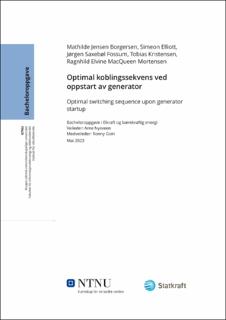| dc.contributor.advisor | Nysveen, Arne | |
| dc.contributor.advisor | Goin, Ronny | |
| dc.contributor.author | Borgersen, Mathilde Jensen | |
| dc.contributor.author | Elliott, Simeon | |
| dc.contributor.author | Fossum, Jørgen Saxebøl | |
| dc.contributor.author | Kristensen, Tobias | |
| dc.contributor.author | Mortensen, Ragnhild Elvine MacQueen | |
| dc.date.accessioned | 2023-08-31T17:19:50Z | |
| dc.date.available | 2023-08-31T17:19:50Z | |
| dc.date.issued | 2023 | |
| dc.identifier | no.ntnu:inspera:142299683:149049608 | |
| dc.identifier.uri | https://hdl.handle.net/11250/3086735 | |
| dc.description.abstract | Elektrifisering og økt andel uregulerbar kraft har ført til større svingninger i strømprisen. Vannkraftverk som tidligere holdt en stabil last, kobler nå inn og ut generatorene sine i takt med prissvingningene. Konsekvensene av denne driftsmodusen for komponentene i kraftverk er foreløpig ukjente. Derfor ønsker Statkraft å utforske hvilken betydning hyppige inn- og utkoblinger har for aldring, risiko, og pålitelighet i vannkraftverk.
Målet med oppgaven er å finne den beste koblingssekvensen for ulike typer vannkraftverk. For å nå dette, må det først etableres hvordan ulike vannkraftverk er satt sammen. Disse strukturene betegnes som topologier. For hver topologi er alle mulige koblingssekvenser identifisert. Til slutt er koblingssekvensene analysert for å finne den beste sekvensen for hver topologi.
Metoden inkluderer en litteraturstudie, intervjuer med fagfolk, og supplerende simuleringer. Litteraturstudiet forsøker å samle relevant forskning på problemstillingen. Det finnes mye teknisk detaljert forskning, men lite som omhandler drift av kraftverk. Gjennom intervjuer med kraftprodusenter samles det inn mye relevant dokumentasjon, samt nyttige synspunkter og driftserfaringer. Denne tekniske vinklingen blir komplementert med teoretiske vinklinger fra professorer ved NTNU. Simuleringer er brukt for å supplere teorien og tydelig vise hvilke transienter som kan oppstå ved hver koblingssekvens.
Resultatene viser åtte distinkte topologier blant de 24 analyserte kraftverkene. To av disse topologiene har trivielle koblingssekvenser. Tre av topologiene har flere koblingssekvenser og blir analysert videre. De siste tre topologiene har koblingssekvenser som bygger videre på de andre koblingssekvensene, og er dermed trivielle.
Konklusjonen er at generatortransformatorer bør kobles ut sammen med generatoren for å redusere tomgangstap. Ved innkobling bør generatorbryteren legges inn før høyspentbryteren slik at transformatorspenningen økes sammen med generatorspenningen. Dette forhindrer høye innkoblingsstrømmer i generatortransformatoren. Kraftverk med mulighet for lokal stasjonsforsyning bør benytte seg av denne forsyningen når generatoren er i drift.
Resultatenes pålitelighet er preget av manglende eksisterende forskning og subjektive meninger som danner beslutningsgrunnlaget. Dette gjør også resultatene lite reproduserbare. Likevel kan resultatene regnes som troverdige, siden det er stor enighet om konklusjonene og resonnementet blant fagpersoner fra mange ulike bakgrunner. | |
| dc.description.abstract | Electrification and an increased share of non-regulatable power have led to greater fluctuations in electricity prices. Hydroelectric power plants, which previously maintained a stable load, are now switching their generators on and off in line with price fluctuations. The consequences of this operating mode for the components of the power stations are currently unknown. Therefore, Statkraft wishes to explore the significance of frequent connections and disconnections for aging, risk, and reliability in hydroelectric power plants.
The aim of this report is to find the best switching sequence for different types of hydroelectric power plants. To achieve this, it must first be established how different hydroelectric power plants are put together. These structures are referred to as topologies. For each topology, all possible switching sequences have been identified. Finally, the switching sequences are analysed to find the best switching sequence for each topology.
The method includes a literature study, interviews with professionals, and supplementary simulations. The literature study attempts to gather relevant research on the issue. A lot of technical research exists, but little that deals with power plant operation. Through interviews with power producers, a lot of relevant documentation is collected, along with useful insight into operational experiences. This technical approach is complemented by theoretical perspectives from professors at NTNU. Simulations are used to supplement the theory and clearly show which transients can occur in each switching sequence.
The results show eight distinct topologies among the 24 analysed power plants. Two of these topologies have trivial switching sequences. Three of the topologies have several switching alternatives and are further analysed. The three remaining topologies have switching sequences that build upon the solutions of the previous topologies.
The conclusion is that generator transformers should be disconnected along with the generator to reduce idle losses. When connecting, the generator circuit breaker should be operated first so that the transformer voltage is increased along with the generator voltage. This prevents high inrush currents in the generator transformer. Power plants with the ability to supply their own electricity locally should take advantage of this when the generator is in operation.
The reliability of the results is impaired by the lack of existing research as well as subjective opinions that form the basis for the conclusions. This also makes the results less reproducible. However, the results can be considered credible, as there is broad agreement on the conclusions and reasoning among professionals from many different backgrounds. | |
| dc.language | nob | |
| dc.publisher | NTNU | |
| dc.title | Optimal koblingssekvens ved oppstart av generator | |
| dc.type | Bachelor thesis | |
